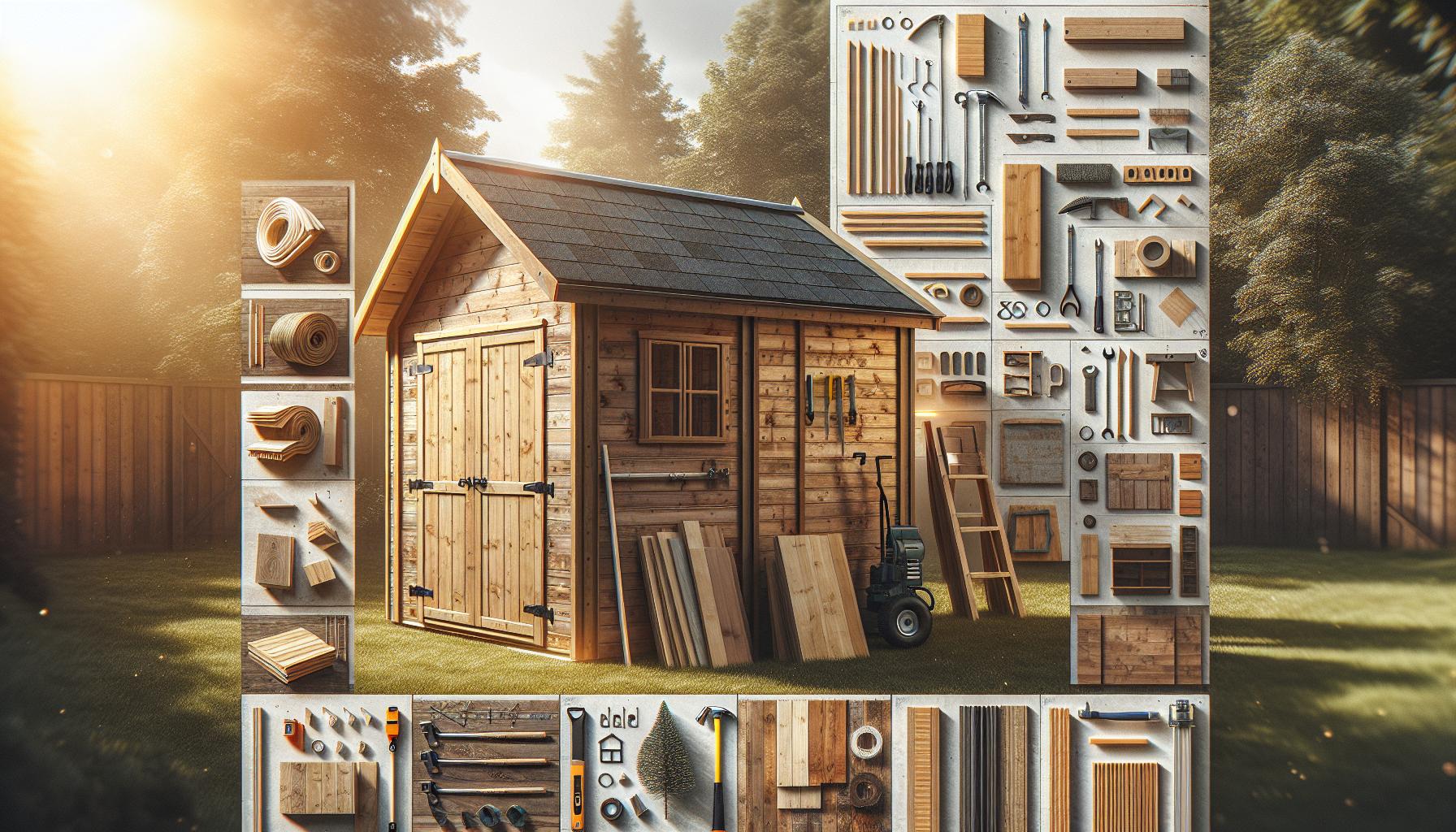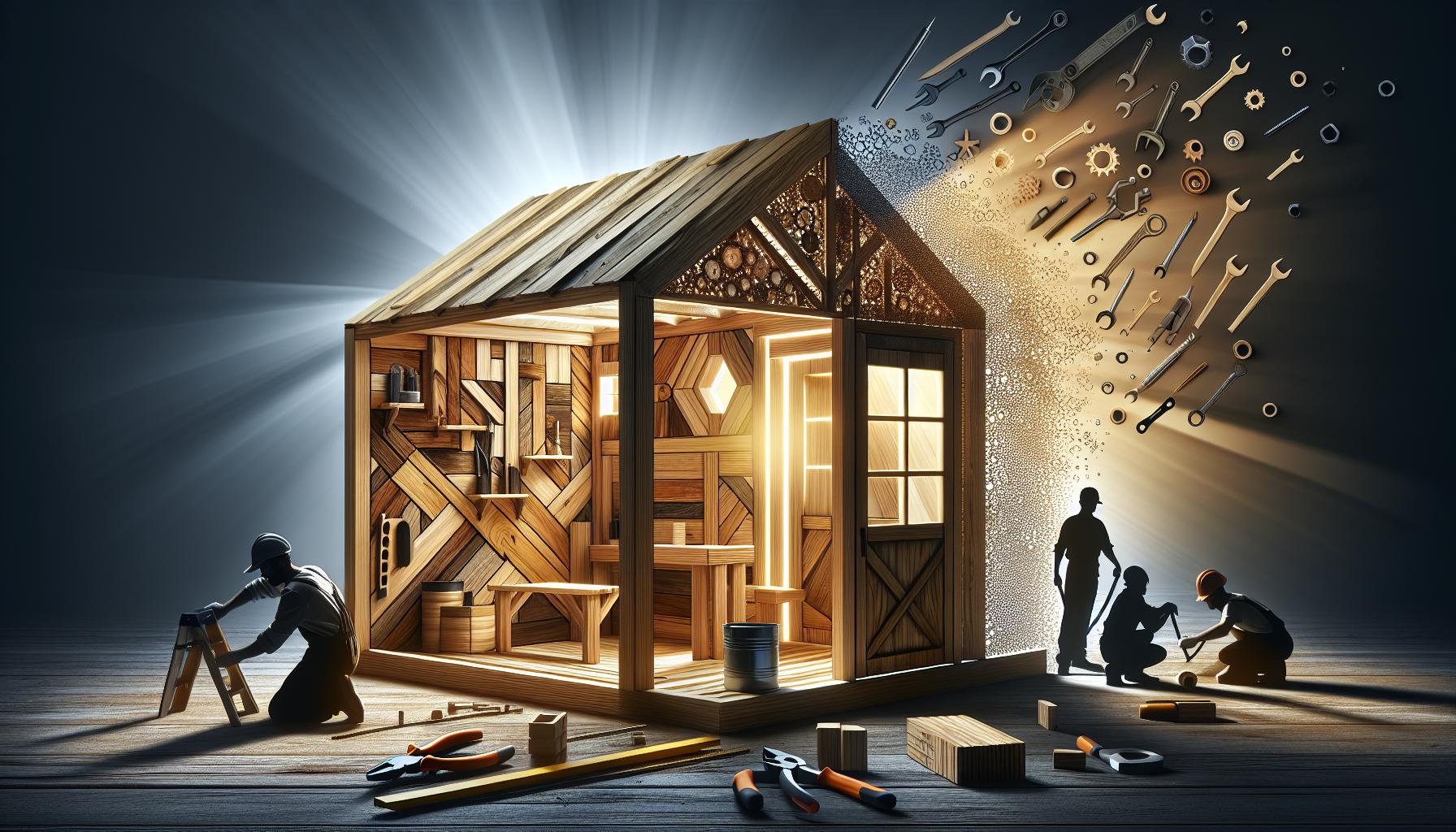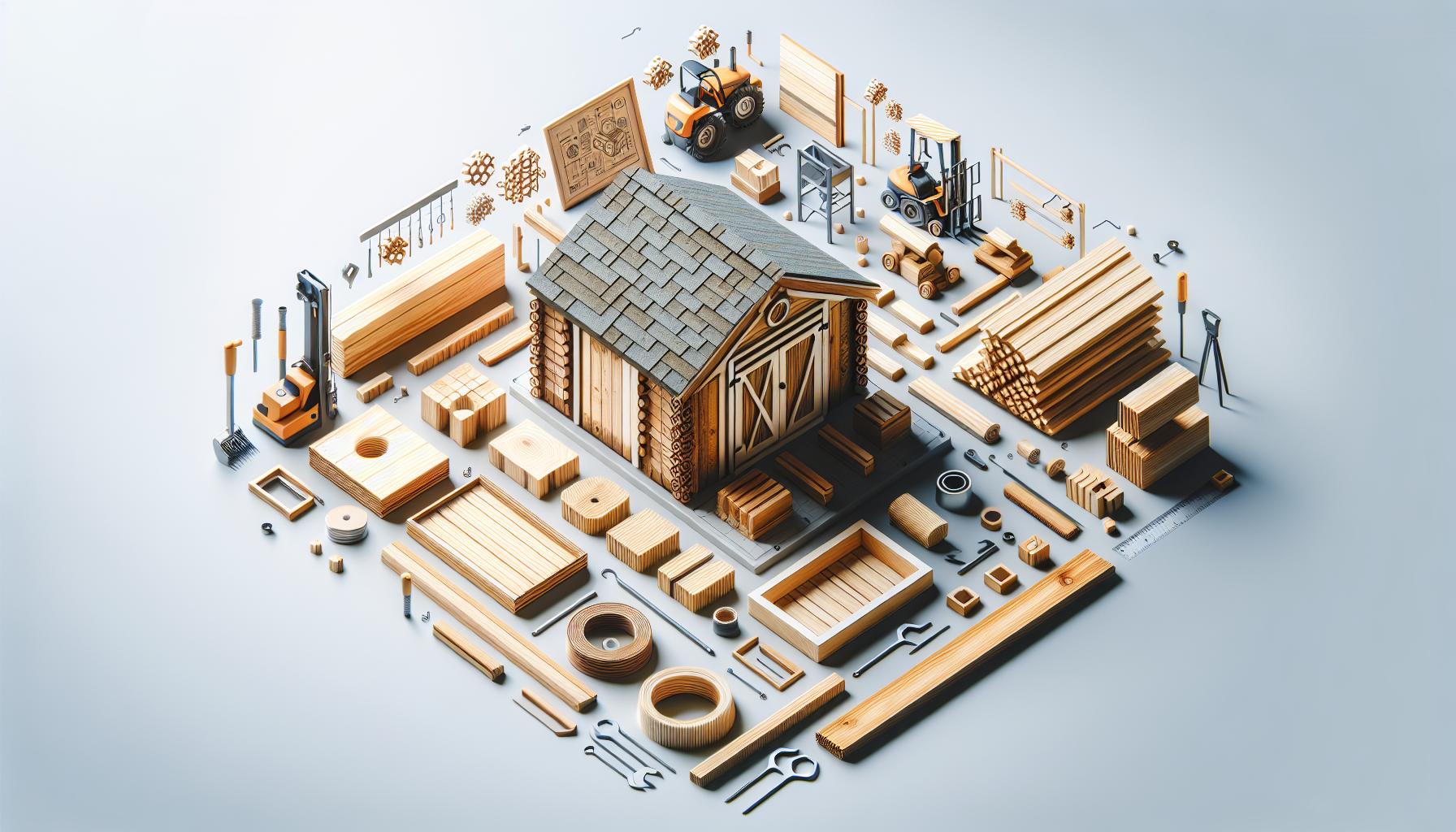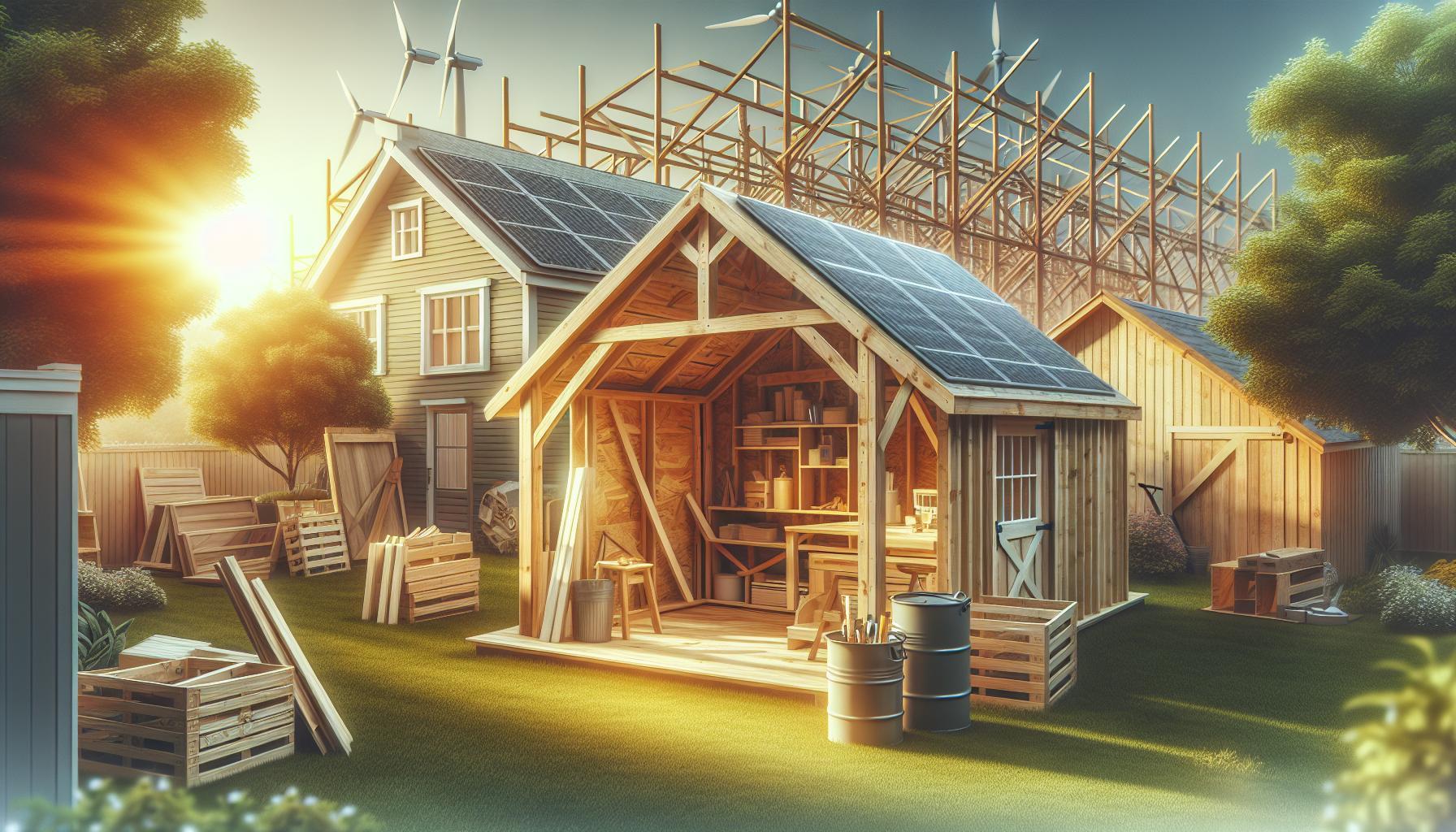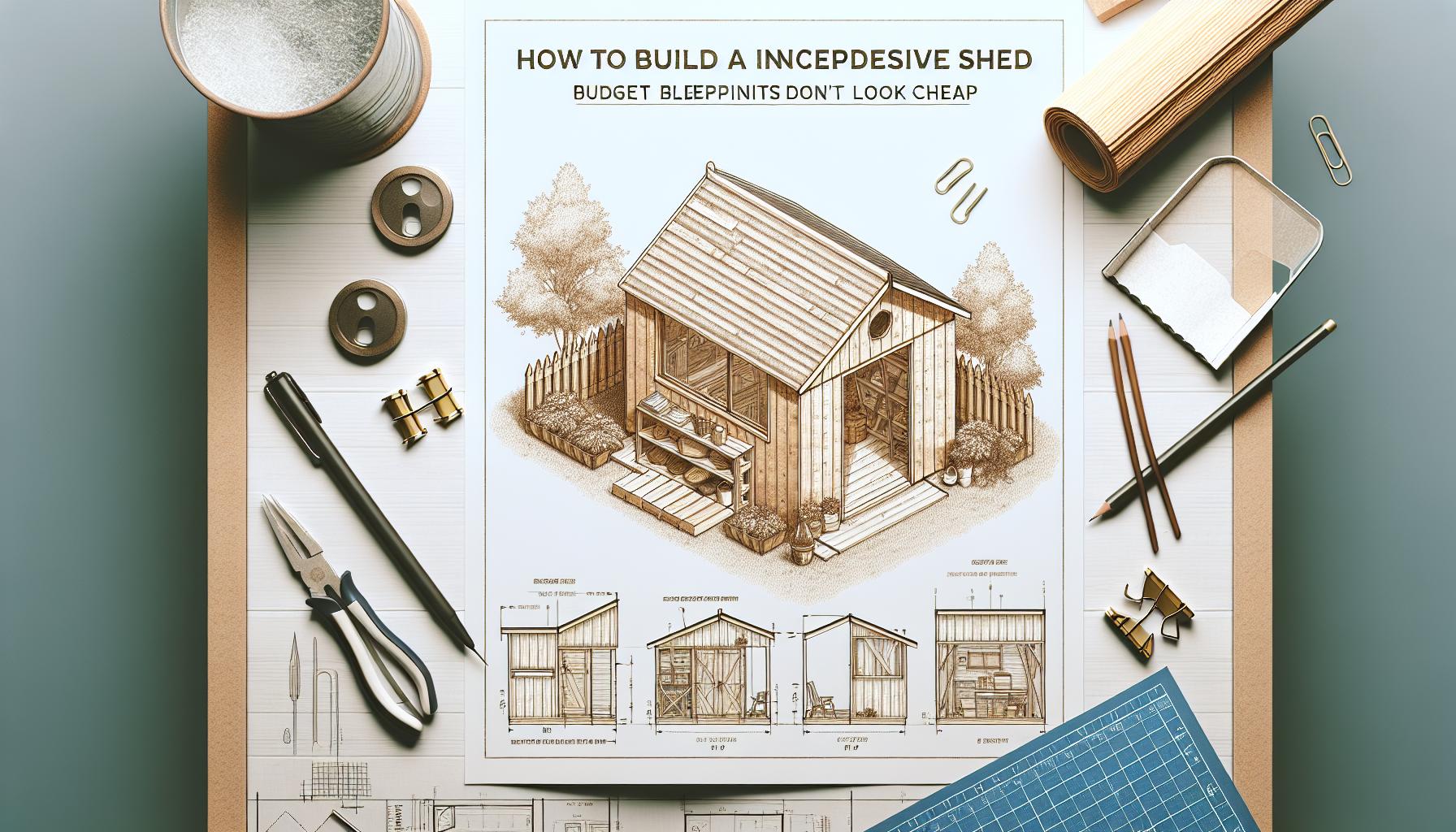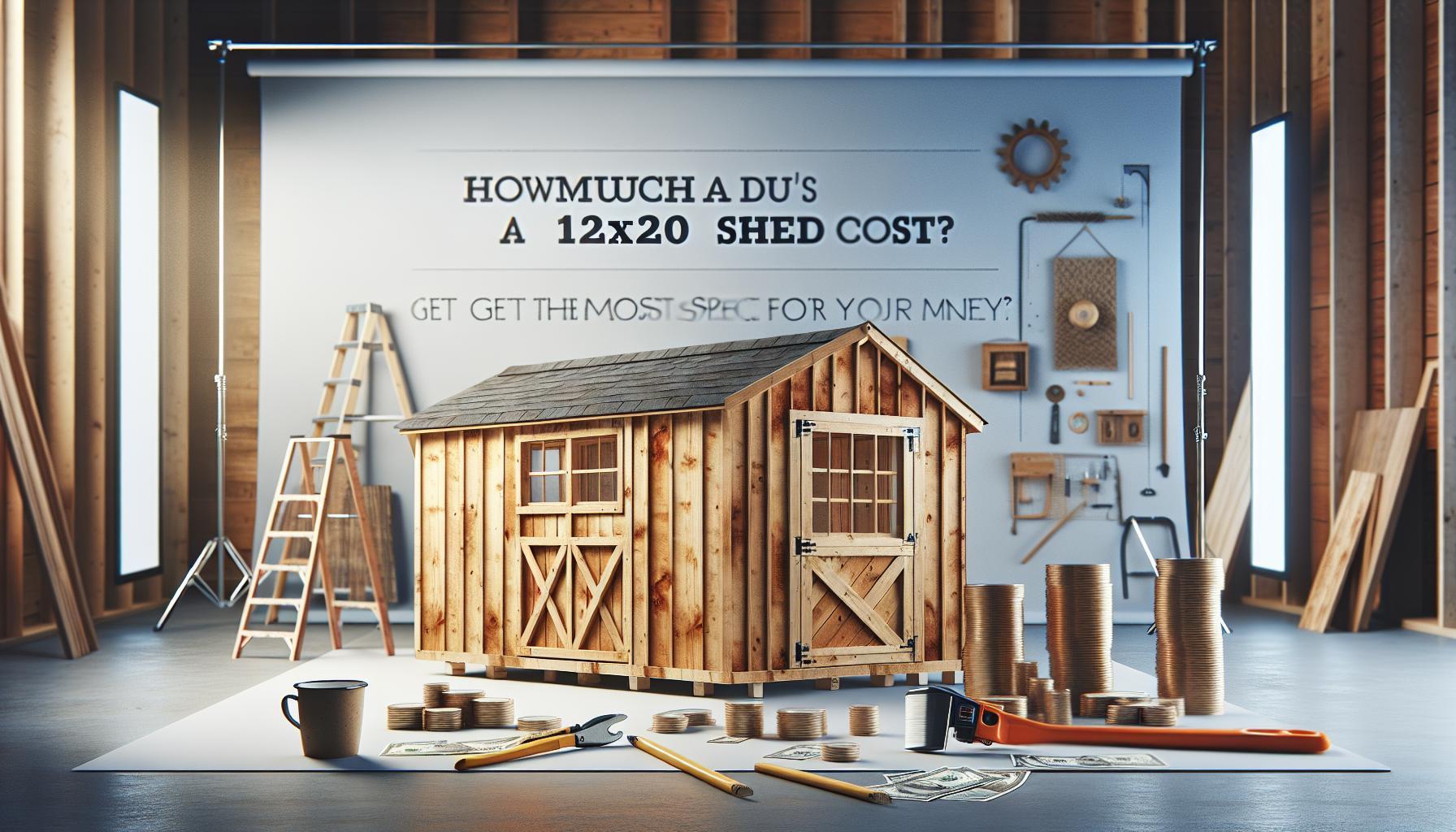Are you dreaming of a storage shed but unsure about the budget? Understanding the costs associated with building a storage shed is crucial, as prices can vary widely based on materials, size, and design. This guide will help you explore price ranges and make informed comparisons to transform your outdoor space efficiently and affordably.
Understanding the Factors That Influence Storage Shed Costs
Understanding the costs associated with building a storage shed involves a multifaceted approach.Numerous elements come into play, shaping the price as you consider both materials and location specifics. From material choices to design features, knowing these factors can arm you with the data needed to make an informed decision and possibly save money.
Material Selection
the materials you choose for your storage shed can substantially impact the overall cost. Commonly, options range from basic wood and metal to high-end composite or vinyl materials. Here’s a breakdown of how different materials influence costs:
| Material Type | Average Cost (per square foot) | Durability |
|---|---|---|
| Wood | $15 – $30 | Moderate (requires maintenance) |
| Metal | $10 – $25 | High (rust-resistant options available) |
| Vinyl | $25 – $50 | Very High (low maintenance) |
| Composite | $20 – $40 | High (durable and weather-resistant) |
Choosing a more durable material may cost more upfront but can lead to long-term savings on repairs and replacements, making it a crucial factor in assessing expenses.
Design and Size
The design and size of your shed directly correlate with the price tag. A simple, rectangular design will generally be less expensive than one with custom features, such as windows, skylights, or elaborate roof styles. Consider the following when assessing the impact of design on storage shed costs:
- Size: Larger sheds require more materials and labor, thus increasing the overall cost.
- Features: Features like shelving, integrated lighting, and insulation can add both function and cost.
- Foundation: The type of foundation—gravel,concrete slab,or timber—will also affect pricing significantly.
Such as, a basic 10×10 wooden shed may cost around $1,000, while incorporating a concrete foundation and additional features could elevate the price to $2,500 or more.
Location and Permits
Your geographical location can dramatically influence storage shed costs, with variations in labor rates, material availability, and local building codes. Areas with higher costs of living may show a marked increase in shed prices due to elevated labor and material costs. Additionally, checking local regulations regarding zoning and permits is essential; cities often have different requirements and fees which can add to your budget.
When budgeting for your shed, don’t overlook the potential need for permits that can range from $50 to several hundred dollars depending on your area. Always begin with thorough research to understand any implications that may affect your costs.
By considering these factors—material selection, design and size, and location nuances—you’ll be better prepared to navigate the complexities of establishing a budget for your new storage shed. Balancing your needs with the inherent costs will enable you to find an option that meets your requirements without overspending, ultimately leading to a purposeful and economical addition to your property.
Breakdown of Material Costs: Choosing the Right Supplies
When considering the costs associated with constructing a storage shed, the breakdown of material expenses plays a crucial role in the overall budget. Each choice of material not only impacts the initial spending but also the long-term durability and maintenance of the shed. By carefully selecting supplies, builders can significantly influence the total cost and functionality of their storage space.
Key Materials and Their Costs
The primary materials that define the overall expenditure in building a storage shed include:
- Wood: Commonly used for framing and siding, prices can vary based on type—pressure-treated lumber tends to be more expensive than standard pine.
- metal: Galvanized steel and aluminum are popular for roofing and siding due to their durability,but they might incur a higher initial cost.
- Vinyl: This low-maintenance option can be cost-effective in the long run, reducing the need for painting or repairs.
- Foundation materials: Concrete blocks, pressure-treated wood, or concrete slabs will add to your costs but are essential for long-term stability.
It’s notable to note that beyond just the price tag, the climate and specific location of the shed must be considered to choose the right materials effectively. As an example, in areas prone to heavy snowfall, investing in higher-quality roofing materials can prevent costly repairs in the future.
cost-effective Strategies for material Selection
When navigating the myriad of options for building supplies, consider these practical steps to optimize your budget:
- Purchase in bulk: many suppliers offer discounts for larger quantities, which can significantly reduce per-unit costs.
- Shop sales and clearance: Timing your purchase during promotions can save you a significant amount of money.
- Compare prices: Utilize online resources and local stores to find the best deals on materials.
Additionally, consider reusing materials from previous projects or sourcing salvaged supplies from local reclamation yards.This not only cuts costs but also promotes sustainability.
| Material | Average Cost per Unit | Durability | Maintenance Needs |
|---|---|---|---|
| Wood | $3 – $8 per board | Moderate | Regular painting/staining |
| Metal | $8 – $15 per square foot | High | Minimal |
| Vinyl | $5 – $10 per square foot | Very High | None required |
| Concrete | $4 – $12 per block | Very High | None required |
By thoroughly understanding the material costs and employing strategic purchasing practices, builders can effectively manage expenses while ensuring their storage shed meets both functional and aesthetic needs.Investing time in the selection process pays off in terms of quality and longevity, making the overall project significantly more worthwhile.
Labor Expenses: DIY vs. Professional Installation
When contemplating the construction of a storage shed, one of the pivotal decisions revolves around whether to tackle the project as a DIY endeavor or to enlist the help of professionals. Each option comes with its unique cost structure and implications, making it essential to weigh them carefully considering both your budget and your skill level. Engaging in a DIY project often brings a sense of achievement and can lead to considerable savings, but it also requires time, effort, and sometimes significant skill.
### DIY Installation Costs
Opting for a do-it-yourself approach means you’ll save on labor costs, which can be substantial. DIY costs typically include:
- Materials: this includes lumber, roofing, nails, and other supplies. Prices vary based on your choices and local market rates.
- Tools: If you don’t already own necessary tools like saws, drills, and levels, renting or purchasing them needs to be factored in.
- Time: While labor costs may be cut, your time is valuable. Consider how many hours you could spend versus how quickly professionals might complete the job.
Many homeowners find success with DIY projects when armed with guidance and plans; however, mishaps can lead to additional costs if materials need replacing or if mistakes require professional corrections.
### Professional Installation Costs
On the other hand, hiring professionals might incur higher upfront expenses, but it can alleviate the strain of physical labor and time management. Professional installation typically encompasses:
- Labor Fees: Skilled contractors will charge not just for their time but also for their expertise, frequently enough resulting in higher hourly or flat-rate prices.
- Insurance and Licensing: Reputable installers should carry liability insurance and be licensed, which adds to the total but offers peace of mind.
- Efficiency: Professionals can often achieve superior results more quickly, potentially leading to fewer overall costs related to delays or errors.
To give you a clearer comparison, here’s an estimated breakdown of potential costs involved in both DIY and professional installations for a typical storage shed:
| Option | Estimated Cost |
|---|---|
| DIY Installation | $500 – $1,500 (materials only) |
| Professional Installation | $1,200 – $3,500 (materials + labor) |
Ultimately, the decision between DIY and professional installation should reflect your budgetary constraints, available time, and comfort with construction tasks. Each has merits depending on your personal circumstances, but understanding these costs can definitely help you navigate the complexities of building a storage shed efficiently. In reviewing how much it costs to build a storage shed, consider not just the monetary figures but also the value of your time and the quality of the final product.
Comparing Pre-Built vs. custom-Built Sheds: Which is Right for You?
When considering the best storage solution for your needs, the choice between pre-built and custom-built sheds plays a crucial role in both convenience and cost-effectiveness. Pre-built sheds offer the advantage of immediate availability, allowing homeowners to quickly have a storage space in their yard. These sheds usually come in standard sizes and designs, which can simplify the purchasing process and reduce wait times. Conversely, custom-built sheds provide a tailored approach, allowing for specific dimensions, styles, and materials that fit perfectly with your property and personal preferences.
Benefits of Pre-Built Sheds
Selecting a pre-built shed can be an attractive option for those seeking convenience. These sheds are typically made in bulk and delivered ready to install, which can significantly reduce both labor costs and time. Here are some key benefits:
- Cost-Effective: Generally, pre-built sheds are less expensive than their custom counterparts due to economies of scale in production.
- Speed: Installation can frequently enough occur within a few hours compared to the weeks that custom sheds may require for design and construction.
- Simplicity: Many homeowners appreciate the straightforward design and size options available, making it easy to choose without extensive research.
Advantages of Custom-Built Sheds
While pre-built sheds have their perks, custom-built sheds stand out for their versatility and personalized design. Here are some advantages to consider:
- Personalization: You have complete control over the shed’s aesthetics and functionality, enabling you to choose materials, colors, and sizes that perfectly match your vision.
- Space Optimization: Custom sheds can be designed for specific purposes, whether for storage, workshops, or even leisure activities, ensuring that every inch of space is utilized effectively.
- Quality Control: With custom builds, you can select higher quality materials that can enhance durability and longevity, potentially offering better value over time.
| Feature | Pre-Built Sheds | Custom-Built Sheds |
|---|---|---|
| cost | Generally Lower | Typically Higher |
| Installation time | Fast (Same Day) | Longer (Weeks) |
| Customization | Limited | High |
| material Quality | Variable | Custom Selection |
choosing between pre-built and custom-built sheds involves weighing the benefits of immediate availability and cost against the desire for personalization and specific functionality. When making this decision, consider your budget, the intended use of the shed, and how much time you are willing to invest in the planning and construction process. Ultimately, both options can serve you well; understanding how much it costs to build a storage shed, as highlighted in the article, will aid in making the best choice for your needs.
Hidden Costs to Consider When Budgeting for Your shed
When planning to build a storage shed, it’s easy to focus solely on the visible expenses like materials and tools; however, there are several hidden costs that can quickly inflate your overall budget. Understanding these potential expenses is essential to ensure that your financial plan is complete and prevents unpleasant surprises down the road. After all, the initial figures in the ‘How Much Does It Cost to Build a Storage Shed: Price guide & Comparisons’ may not tell the whole story.One significant area frequently enough overlooked is the foundation. Depending on your local climate and soil conditions, a solid base might require more than just a flat, level area. You may need a concrete slab, gravel, or even piers for proper drainage and stability. Here’s a breakdown of common foundation types along with their estimated costs:
| Foundation Type | Estimated Cost |
|---|---|
| Gravel Base | $200 – $500 |
| Concrete Slab | $300 – $1,200 |
| Piers | $400 – $800 |
Additionally, don’t underestimate the cost of permits and regulations. Before you begin construction, ensure you check local zoning laws and building regulations, as many areas require permits for sheds over a certain size. Fees for permits can vary widely but typically range from $50 to $500, potentially affecting the total price you budgeted for your shed.
Beyond the initial investment, ongoing maintenance costs can add up over time. This includes routine maintenance like painting, sealing, or repairing roof shingles. Such as, depending on the materials used, you might expect to spend an additional $100 to $300 annually just to keep your shed in good shape and prevent more costly repairs down the line.
furthermore, if you opt for custom features such as windows, shelving, or climate control systems, these enhancements can significantly increase your initial budget. It’s advisable to factor in costs for these upgrades early on so you can adjust your overall budget accordingly. Aim for a comprehensive estimate to align with the insights provided in ‘How Much Does It cost to Build a Storage Shed: Price Guide & Comparisons’ while also preparing for those unexpected expenses.
Essential Features to Add Value to Your Storage Shed
when you’re investing in a storage shed,it’s not just about the initial cost of construction. The real value comes from well-thought-out features that enhance functionality and usability. By incorporating essential elements into your storage shed design, you can optimize your space for both storage and organization, making it a versatile addition to your property.
Smart Organizational solutions
A cluttered shed can quickly negate the benefits of having additional storage space. consider adding built-in shelving, pegboards, or cabinets to keep tools and equipment organized and accessible. Additionally, utilizing vertical space by installing ceiling racks or wall-mounted storage can dramatically increase your shed’s capacity without requiring a larger footprint.
- Built-in Shelves: Perfect for storing boxes and small equipment.
- pegboards: Excellent for hanging tools and keeping them visible.
- Storage Cabinets: Ideal for securing valuable items and maintaining a tidy appearance.
Incorporate modular storage solutions that allow you to adjust the arrangement as your storage needs evolve, giving you the flexibility to maximize the use of your shed over time.
Durability and Weather resistance
Investing in high-quality materials not only impacts the initial budget but also the long-term maintenance costs. Opt for weather-resistant materials such as vinyl siding, metal roofing, or pressure-treated lumber to withstand the elements. This choice not only extends the lifespan of your shed but may also reduce yearly maintenance expenditures.
| Material | Cost per Square Foot | Durability | Maintenance |
|---|---|---|---|
| Vinyl Siding | $5 – $8 | 20+ years | Low |
| Metal Roofing | $7 – $10 | 40+ years | Very Low |
| Pressure-Treated Lumber | $3 – $6 | 10 – 30 years | Medium |
By balancing cost with durability and maintenance, you ensure your storage shed remains a valuable asset rather than a burden.
Access and Convenience Features
Ease of access can significantly enhance the usability of your storage shed. Large double doors not only provide easy access for bulky items but also encourage better organization, as moving things in and out becomes a hassle-free task. Consider adding a ramp for wheeled equipment or gardening carts, ensuring you can transport items with minimal effort.
Lighting is another vital aspect that is frequently enough overlooked. Installing overhead lights or windows can transform a dark shed into a radiant workspace, making it easier to find tools and supplies when you need them.Incorporate these essential features to create a storage shed that not only meets your needs but also maximizes potential use. By planning wisely and integrating value-adding elements,you can ensure your investment is worthwhile,resonating with the insights gathered in our guide on “How Much Does It Cost to Build a Storage Shed: Price Guide & Comparisons”.
Tips for Saving Money Without Sacrificing quality
When embarking on the journey to build a storage shed, potential cost savings can be as crucial as the quality of materials and construction itself. Understanding how to save money effectively without compromising on the quality of your storage shed will allow you to create a functional and durable structure while staying within your budget. Engaging in thoughtful planning and strategic purchasing can make all the difference.
Choose the Right Materials
selecting the right materials is essential for balancing cost and quality. While opting for the cheapest materials might seem attractive upfront, they can lead to higher replacement costs in the long run. Consider durable materials like pressure-treated wood or metal that withstand weather elements.Research various suppliers to compare costs and look for opportunities to buy materials in bulk or during sales events. Another way to save is by utilizing recycled materials or second-hand items that are still in good condition.
DIY vs. Professional Help
Deciding whether to tackle the project yourself or hire a professional can significantly affect your budget. If you possess basic carpentry skills, embracing a DIY approach can save you a substantial amount of money on labor costs. There are numerous online resources and tutorials that guide you step-by-step through the building process. If the project seems daunting, consider hiring a professional for essential tasks while completing the simpler parts of the build independently. This hybrid approach can allow you to maintain quality while reducing costs.
Smart Design Choices
Designing your storage shed wisely can lead to meaningful savings. Simple designs tend to require fewer materials and less time to build. Consider opting for a shed with a straightforward rectangular shape which minimizes waste and complexity.Additionally,build your shed to match your landscape and existing structures to avoid costly alterations later on. Be sure to consult a price guide like “How Much does It Cost to Build a Storage Shed: Price Guide & Comparisons” to make informed decisions about features and dimensions that fit your needs and budget.
| Cost-Saving Tip | Details |
|---|---|
| Material Selection | Choose durable materials; consider recycled or second-hand options. |
| DIY involvement | Take on manageable tasks yourself; hire professionals for complex work. |
| Shed Design | Opt for simple, functional designs to minimize materials and labor. |
By implementing these strategies, you can build a storage shed that not only meets your storage needs but also aligns with your financial goals. Effective planning, material selection, and design considerations can help ensure that you’re saving money without sacrificing the quality of your project.
Planning Your Shed Project: A Step-by-Step guide to Staying on budget
Creating your dream storage shed can be an exciting yet daunting project, especially when it comes to budget management. With the average cost to build a storage shed varying widely based on size, materials, and location, meticulous planning becomes crucial. In this guide,we’ll walk you through practical steps to maintain budgetary control while ensuring your build meets both your needs and your financial limits.
Establish Your Budget Early
Before you dive into design ideas or materials, it’s important to define a clear budget. Start by asking yourself the following questions:
- what is the primary purpose of the shed?
- How much space do you need?
- Are there specific features or amenities you want?
- What’s the maximum amount you’re willing to spend?
Once you answer these questions, create a spreadsheet detailing all potential costs associated with your project. This could include materials, labor (if any), permits, and even tools you might need to purchase or rent. Remember to account for unexpected expenses by allocating at least 10-20% more than your anticipated total.
Research and Compare Costs
Understanding the factors influencing the cost of building a storage shed is essential. Based on the article “How Much Does It Cost to Build a Storage Shed: Price Guide & Comparisons,” costs vary by shed type,size,and material. Here’s a brief overview of average costs:
| Shed Type | Average Cost Range |
|---|---|
| Wood Shed | $1,500 – $4,500 |
| Metal Shed | $800 – $2,000 |
| Vinyl Shed | $1,200 – $3,500 |
Utilize various resources such as local suppliers, online marketplaces, and reputable websites to gather price quotes. Don’t hesitate to reach out to multiple vendors for comparisons and potential discounts.
Consider DIY vs. Hiring Help
Another significant factor that affects your shed project budget is whether you’ll build it yourself or hire professionals. If you have basic carpentry skills and the time to dedicate, a DIY approach can save you money. There are countless resources, including detailed guides and video tutorials, that can help you through the construction process.
On the other hand, if you’re less confident in your building skills or want to save time, hiring a contractor might be the way to go. Just ensure you get multiple quotes and check references. Be aware that labor can range from 15% to 50% of your total project cost, so factor this into your planning.
By taking these actionable steps—establishing a realistic budget, researching costs thoroughly, and weighing the pros and cons of DIY versus hiring help—you’ll have a clear roadmap to avoid financial pitfalls while creating your perfect storage solution.
Faq
How much does it cost to build a storage shed?
Building a storage shed typically costs between $1,000 to $10,000, depending on factors like size, materials, and design. A simple wooden structure will be on the lower end, while larger, custom-built options can be significantly more expensive.
When considering how much does it cost to build a storage shed, remember to factor in costs for permits, foundation, and insulation if needed. Additionally, labor costs can vary based on whether you’re hiring professionals or going the DIY route. For specific cost breakdowns, refer to our comprehensive cost guide.
What factors influence the cost of building a storage shed?
Several factors influence the overall cost of a storage shed, including size, materials, complexity of design, and location. Basic sheds will call for fewer resources, thus costing less than intricate custom designs.
For instance, if you opt for high-quality materials like cedar or metal, your expenses will escalate. Additionally, geographical variations affect labor and material costs, so it’s critically important to check local pricing to get an accurate estimate.
Can I save money by building my own storage shed?
Yes, building your own storage shed can save you a substantial amount of money, potentially reducing the total cost by 30-50% or more. Doing it yourself allows you to control material selection and labor expenses.
However, consider the time investment and the need for specific tools. For many DIYers,the satisfaction of building their own shed combined with the cost savings makes it a worthwhile project. Be sure to gather adequate resources and plans; we provide some helpful DIY shed plans you can use.
Why should I choose custom-built sheds over pre-fabricated options?
Custom-built sheds provide flexibility in size and design, allowing you to tailor the structure to your particular needs, unlike pre-fabricated units which come in standard styles and sizes. This customization can enhance functionality.
Moreover, custom options allow you to use materials and colors that blend seamlessly with your property. While custom builds might potentially be pricier upfront, they can increase your property value and better meet your specific storage needs.
What is the average size of a storage shed?
The average size of a storage shed is between 100 to 400 square feet, suitable for typical residential storage needs. However, sizes can vary widely based on individual requirements.
Such as, a small shed could be perfect for garden tools and bikes, while larger options might store lawn equipment and seasonal decorations. always assess your storage needs closely before making a decision to avoid overspending on space you don’t require.
Are there ongoing costs associated with maintaining a storage shed?
Yes, there can be ongoing maintenance costs for your storage shed, including repairs, cleaning, and potential upgrades over time. Budgeting for these costs is crucial to ensure longevity.
Regular inspections and repairs can prevent small issues from becoming expensive problems. You should also consider weatherproofing treatments and potential utility costs if you plan to use electricity or heating. Keeping your shed in good shape ensures it remains a viable storage solution for years.
What materials should I consider for my storage shed construction?
Common materials for storage sheds include wood, metal, and vinyl, each offering various benefits. Wood provides a classic look while being easily customizable; metal is durable and low-maintenance; vinyl is often weather-resistant and long-lasting.
When choosing materials, consider your local climate, the shed’s purpose, and your budget. If you’re uncertain, our material comparison guide can help you select the best option for your project.
In Summary
in wrapping up this comprehensive guide on the costs associated with building a storage shed, it’s clear that planning is key to a accomplished project. By understanding the various factors that influence price—from materials and design options to labor and location—you can make informed decisions that align with your budget and needs.
Remember, every successful DIY endeavor begins with a strong foundation in research. Whether you’re leaning towards a pre-fabricated model or crafting a custom shed from scratch, tackling the project step-by-step will not only save you money but also give you that satisfying sense of accomplishment that comes with quality craftsmanship.If you’re feeling overwhelmed by the process, take a moment to break it down into manageable tasks. Consider your specific requirements and remember, it’s perfectly okay to ask for help or seek advice along the way. Each challenge you encounter can serve as an opportunity to expand your skills and confidence in DIY.
We encourage you to explore further resources and guides on shed designs and construction techniques to broaden your understanding and inspire your creativity. Dive in, embrace the process, and soon enough, you’ll be well on your way to building a storage shed that not only meets your practical needs but also enhances your property’s appeal. Happy building!


